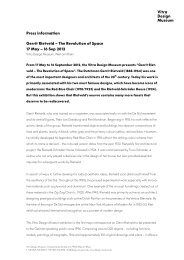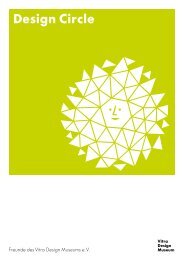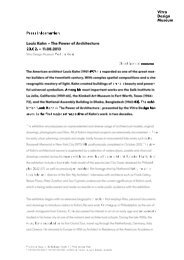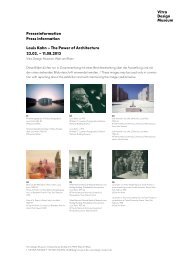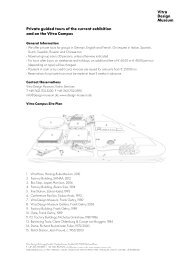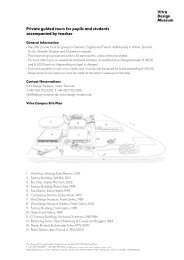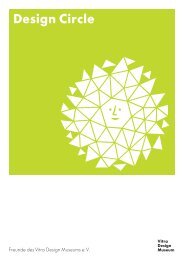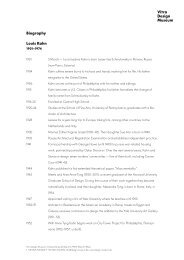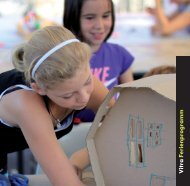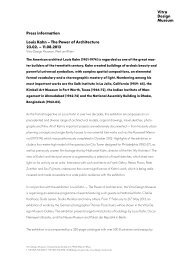Louis Kahn Programm pdf - Vitra Design Museum
Louis Kahn Programm pdf - Vitra Design Museum
Louis Kahn Programm pdf - Vitra Design Museum
Create successful ePaper yourself
Turn your PDF publications into a flip-book with our unique Google optimized e-Paper software.
Quinta Monroy Housing, Alejandro Aravena, Chile 2003–05<br />
»It is about being<br />
human.«<br />
Alejandro Aravena (born 1967) runs his<br />
own architectural office in Santiago de<br />
Chile. He was a Visiting Professor at Harvard<br />
University, is a member of the Pritzker<br />
Prize jury and an International Fellow<br />
of the Royal Institute of British Architects.<br />
As executive director of the company Elemental,<br />
he has been engaged in social<br />
building projects. In conjunction with the<br />
exhibition »<strong>Louis</strong> <strong>Kahn</strong> – The Power of<br />
Architecture«, we spoke with Aravena<br />
about <strong>Kahn</strong>’s work and his relevance for<br />
contemporary architecture.<br />
Which of <strong>Kahn</strong>’s buildings and books made the<br />
strongest impression on you and why?<br />
When I arrived in India, in Ahmedabad, for the<br />
first time in 2009 – and actually I was not aware<br />
of which building was I visiting – I just stepped<br />
out of a car and was in this building and my<br />
first reaction was, »Fuck! What the fuck is this?!«<br />
And, of course, after a couple of seconds you<br />
realize this must be <strong>Kahn</strong>. It was the Indian Institute<br />
of Management. And that was a kind of<br />
»hit in the face«. A raw thing. A building that<br />
could have been two thousand years old, or<br />
could have been built in the present decade,<br />
it was so hard to tell. So fine-tuned and so appropriate<br />
for the context, for the weather, for<br />
the use, for the level of development in India,<br />
in the sense of being able to live with poverty,<br />
but simultaneously raising the standard of the<br />
quality of life, even in very simple terms. That<br />
was one of those major impressions that makes<br />
you go back to the office and say, »Stop; we<br />
have to stop what we’re doing.«<br />
You also went to visit Bangladesh. What impact<br />
did the Capital Complex in Dhaka have on you?<br />
In Dhaka, I think the entire journey was important<br />
to judge the building: the fact that you arrive in<br />
such a poor country and at a building that is one<br />
of the highest points in the body of knowledge<br />
that architecture has been able to accumulate.<br />
One of the biggest impressions was that jump in<br />
scale from detail to the overall volume. Another<br />
was this extraordinary capacity of the building<br />
to work well against everyday life. On Sundays<br />
entire families are around, using it as a place for<br />
enjoyment. While it is such an abstract element<br />
that is studied as a piece of art, it also resists that<br />
careful attention and has the capacity to be just in<br />
the background of life. It has the capacity to be a<br />
piece of high and global culture while interpreting<br />
the local condition of a specific group of people.<br />
This building synthesizes both. That happens very<br />
rarely in the history of architecture.<br />
You have called your office Elemental. Could you<br />
elaborate on that?<br />
Dealing with scarcity you have two choices:<br />
complain about not having enough resources<br />
or try to transform scarcity into a filter against<br />
arbitrariness and the superfluous. While dealing<br />
with low-income housing or with urban projects<br />
in a developing country such as Chile or Latin<br />
America in general, we are forced to leave out<br />
everything that is not strictly necessary. And we<br />
think that is a privilege because it eventually<br />
allows us to approach life and its most archaic<br />
needs. This is timeless. It is not about survival but<br />
about being human in its most pure state. Like<br />
having a good conversation. How do I relate to<br />
my family? How do I create relationships with my



